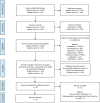Mortality in congenital hemophilia A - a systematic literature review
- PMID: 33331043
- PMCID: PMC7839505
- DOI: 10.1111/jth.15189
Mortality in congenital hemophilia A - a systematic literature review
Abstract
Against a background of a rapidly evolving treatment landscape, a contemporary, evidence-based consolidated understanding of mortality in people with congenital hemophilia A (PwcHA) is lacking. This systematic literature review examines the available data on mortality and causes of death in PwcHA to enable a better understanding of fatalities in PwcHA and evaluate the impact of new treatment paradigms on mortality. A systematic literature review of observational studies was conducted by searching Medline, Embase, and clinical trials registries for articles published from January 2010 to March 2020, using the search terms: hemophilia A (HA), mortality, cause of death. Interventional studies, studies not reporting fatalities, and those reporting only on hemophilia B, acquired HA, or mixed other coagulopathies were excluded. Overall, 7818 unique records were identified and 17 were analyzed. Of these, six reported mortality rates and five reported mortality ratios. Mortality generally decreased over time, despite a spike associated with human immunodeficiency virus (HIV)/hepatitis C virus (HCV) infection in the 1980s and 1990s. Mortality was strongly correlated with age and hemophilia severity. People with hemophilia had a raised mortality risk compared with the general population, particularly in severe hemophilia, and when infected with HIV or HCV. Causes of death varied across populations, countries, and time in 15 identified studies; however, incomplete and heterogeneous reporting limits evidence. Hemorrhage, HIV, HCV, and hepatic disease were the leading causes of death. A unified approach to reporting mortality and cause of death is needed to understand mortality in PwcHA as treatments continue to advance.
Keywords: benchmarking; cause of death; hemophilia A; mortality; systematic review.
© 2020 The Authors. Journal of Thrombosis and Haemostasis published by Wiley Periodicals LLC on behalf of International Society on Thrombosis and Haemostasis.
Conflict of interest statement
None of the authors received honoraria or fees for their contribution to the development of this manuscript or supplement. Dr. Nissen is a current employee of F. Hoffmann‐La Roche Ltd. Dr. Hay has received consultancy and honoraria from Shire Plc., Alnylam Pharmaceuticals Inc, Novo Nordisk, Swedish Orphan Biovitrum AB (Sobi), and F. Hoffmann‐La Roche Ltd; has participated in speakers’ bureaus for Shire Plc., Sobi, F. Hoffmann‐La Roche Ltd, and Pfizer Inc; has received research funding from Bayer, Shire Plc., Sobi, Novo Nordisk, and Pfizer Inc; and has received travel and accommodation expenses from F. Hoffmann‐La Roche Ltd, Sobi, CSL Behring, and Shire Plc. Dr. Pipe has received consultancy and honoraria from Apcintex Ltd., Bayer AG, BioMarin Pharmaceutical, Catalyst Biosciences, CSL Behring, HEMA Biologics Inc, F. Hoffmann‐La Roche Ltd., Freeline Therapeutics, Novo Nordisk, Pfizer Inc, Sangamo Therapeutics Inc, Sanofi, Takeda Pharmaceutical Company Ltd., Spark Therapeutics Inc, and uniQure NV; has received research funding from Siemens AG; and is a member of the board of directors/advisory committee for the Medical and Scientific Advisory Council to the National Hemophilia Foundation and the Medical Advisory Board to World Federation of Hemophilia.
Figures


References
-
- Franchini M, Mannucci PM. Hemophilia A in the third millennium. Blood Rev. 2013;27:179‐184. - PubMed
-
- Plug I, Van Der Bom JG, Peters M, et al. Mortality and causes of death in patients with hemophilia, 1992–2001: a prospective cohort study. J Thromb Haemost. 2006;4:510‐516. - PubMed
-
- Pool JG, Gershgold EJ, Pappenhagen AR. High‐potency antihaemophilic factor concentrate prepared from cryoglobulin precipitate. Nature. 1964;203:312. - PubMed
Publication types
MeSH terms
LinkOut - more resources
Full Text Sources
Medical

